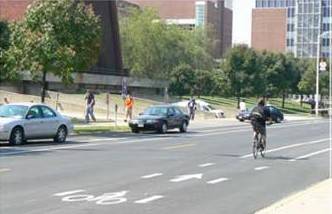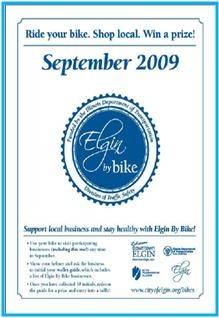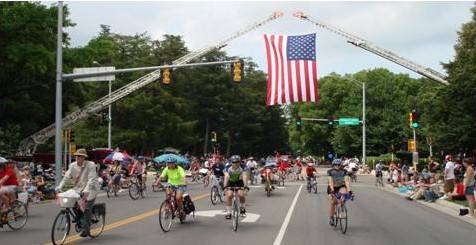Five years ago there were no bike lanes or bike plans in either Urbana or Champaign. A few intrepid cyclists bicycled year-round and people bicycled on campus. Over the last five years a lot of remarkable things began to happen.
First, bicyclists began to show up and participate in planning processes such as the big.small.all county visioning effort. A vision for making the area a better place to walk, bike and use transit began to emerge. From this Champaign County Bikes was created and began working on educating the public and bicyclists and serving as a public face for the cycling community.
Three years ago the increase in bicycling began to become evident in our community with bicycle parking spaces overflowing at places like Illinois Terminal and more cyclists on the streets. Both cities began taking a second look at bicycle infrastructure. Champaign approved a new multi-modal transportation plan that included a vision for bicycling called: “Champaign Moving Forward” (pdf). Urbana created and adopted the award-winning “Urbana Bicycle Master Plan“.
Now the cities are moving forward with implementing the plans. Urbana was recently recognized by the League of American Bicyclists (LAB) as a Bicycle Friendly Community, the only city in downstate Illinois to achieve this honor. The Champaign-Urbana Mass Transit District and the City of Champaign have both been recognized by LAB as Bicycle Friendly Businesses. The benefits of becoming a bicycle friendly community are multifold.

Installing more bicycle infrastructure has proven to reduce crash rates and decrease fatalities in other cities. In Chicago a study found that not only did bicycle/vehicular crashes decrease, but all vehicular crashes decreased on streets where bike lanes were installed. Other communities that have installed bike lanes, bike routes, bike paths, and more bike parking have seen a decline in crashes and fatalities of cyclists even as the number of cyclists has increased.
Portland, Oregon set the example beginning their effort to become a bicycle friendly community in the 1990’s. Since 1996 Portland has doubled the miles of bike lanes, seen a four-fold increase in bicycling, installed thousands of bicycle parking spaces, and seen a dramatic decrease in bicycle crashes and fatalities.

Source: City of Portland, Ore.
A large body of evidence shows that installing bicycle infrastructure increases safety for all roadway users. A Federal Highway Administration study found “[a] comparison of crash rates of all types in major cities has shown that cities with higher bicycle use have lower traffic crash rates of all types than cities with lower bicycle use.” When the city of Corvallis, Ore., installed 13 miles of bicycle lanes in one year, the number of bicycle crashes fell from 40 in the year prior to the installation to just 16 in the year afterwards. Davis, Calif., had a 31% reduction in bike crashes after the addition of bike lanes.
In addition to a decrease in crashes and fatalities when bike lanes and other bicycle infrastructure are installed in a community the research has found that all roadway users more frequently follow the laws. The study by the Federal Highway Administration found
- 81% of bicyclists obeyed Stop signs on streets that had bike lanes as opposed to 55% obeying Stop signs on streets without bike lanes
- Wrong-way riding was significantly lower on the streets with bike lanes
- Corvallis and Eugene, Oregon, cities with good bikeway networks, have the highest number of riders and rider behavior is the best: wrong-way riding is minimal; fewer ride on the sidewalk than in other Oregon cities.
In addition to the safety benefits of bicycle infrastructure studies have shown that communities benefit economically when bicycle infrastructure is installed. Several studies have shown that merchants on streets where bike lanes have been installed have seen an increase in business. One study showed that customers that walked and bicycled to shop a neighborhood commercial district, in which bike lanes were installed, spent significantly more than those customers who drove cars to shop.
 Surveys of merchants on streets where bike lanes have been installed have shown that the majority felt that the bike lanes had a positive impact on business. In Elgin, Ill., the community began an “Elgin by Bike” program that included lots of Bike and Dine Events. One merchant said, “From my point of view I thought it went well. About two-thirds of the riders had not been in our shop, so that was great to see new potential customers.”
Surveys of merchants on streets where bike lanes have been installed have shown that the majority felt that the bike lanes had a positive impact on business. In Elgin, Ill., the community began an “Elgin by Bike” program that included lots of Bike and Dine Events. One merchant said, “From my point of view I thought it went well. About two-thirds of the riders had not been in our shop, so that was great to see new potential customers.”
In Portland, Ore., the city began a “Bike Corral” program that converts on-street vehicle parking spaces to bicycle parking. The Bike Corrals (like those on Gleason St., shown below) are installed at the merchant/property owner’s request. So far, 50 bike corrals have been installed and there is a waiting list for 62 additional parking conversions to bicycle parking. Merchants have found that 10-12 customers can park in a bike corral where one car used to park so increasing bicycle parking has increased their business.

Creating bicycle infrastructure has been shown to have significant safety and economic benefits. In addition to these benefits bicycling is the most efficient form of transportation in terms of fuel used and Green House Gases (GHG) produced. About 50% of the average American households GHG emissions are for transportation. Switching a few trips per week per household to walking/ bicycling/transit has more impact on reducing GHG emissions than replacing all household light bulbs with compact fluorescents, increasing insulation, replacing energy inefficient appliances, and replacing windows with energy efficient ones. Any community that wants to reduce its carbon footprint has to provide infrastructure for walking, biking, and transit to give residents safe, easy, and accessible transportation choices.
Access to infrastructure for bicycling can also have a huge impact on community health. Portland has one of the lowest obesity rates in the United States. When people can easily run errands, go to the store, head out to eat at a restaurant by bicycling or walking they get a lot more exercise. Being able to incorporate 30 minutes of walking or bicycling into everyday activities could have a huge impact on community health.
The benefits are multiple and include safety, health, and economic benefits. Bicycle infrastructure has been proven to provide these benefits across the country. Champaign and Urbana are on the way to becoming bicycle friendly, safer, and healthier communities.









